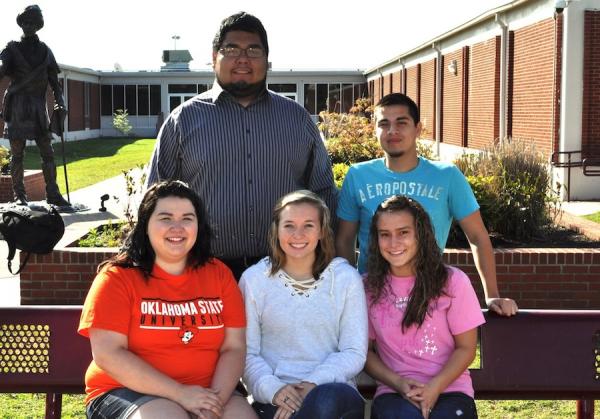
Pictured are the six Gates Millennium Scholars from Sequoyah High School in Tahlequah, Oklahoma. Pictured, from left, in the front row, are Lakin Keener, Nicole Mangels and Rikki Duvall. Pictured, from left, in the back row, are Zane Kee and Tyler Handle. Not pictured: Nathalie Tomasik.
September 04, 2013
While most parents and students are just thinking about getting back to school, high school students should always be thinking about applying to as many scholarships as possible. The more money that can be earned through scholarships means less loans to pay back later.
Here are 6 places for Native students to start looking:
The Gates Millennium Scholars program chooses 1,000 minority students each year—150 of which are Native—to receive scholarships of up to $250,000 that are good until they graduate at a university of their choice. Just keep in mind that while becoming a Gates Scholar will be worth the effort, it won’t be an easy task.
“The application process was really grueling,” said Lakin Keener, 18, a 2013 Gates Scholar from Sequoyah High School. “I spent six months on it. I probably spent two months on one essay alone.”
Applications for the 2014 Gates Millennium Scholars program are due January 15, 2014. For more information, visit GMSP.org.
The American Indian College Fundhas been providing Native students with scholarships and other support since 1989. Alli Moran, Cheyenne River Sioux, is one of those students. The American Indian College Fund has helped her get through attending the Institute of American Indian Arts in Santa Fe, New Mexico. She’s in her third year toward obtaining a bachelor’s degree in indigenous liberal studies and a certificate in business and entrepreneurship.
Application deadlines vary for scholarships offered by the American Indian College Fund. For more information, visit CollegeFund.org.
Catching the Dreamoperates three scholarship programs for Native students—MESBEC, the Native American Leadership Education program and the Tribal Business Management program. MESBEC includes math, engineering, science, business, education and computers and is fund’s oldest program. “These fields are the ones in which tribes need graduates the most, and the fields in which there are the fewest Indian graduates,” says the Catching the Dream website.
The deadline for the spring semester is September 15. For more information, visit CatchingtheDream.org.
The American Indian Science and Engineering Society provides scholarships to Native students in an effort to increase the representation of American Indians and Alaska Natives in STEM—science, technology, engineering and math—fields.
The 2013 AISES National Conference will be held October 31 to November 2 in Denver, Colorado, this year’s theme is Elevate. Applications for travel scholarships to attend are due by September 6. For more information, visi tAISES.org.
The Association on American Indian Affairs began in 1922 as the Eastern Association on Indian Affairs. It was started to help protect the land rights of a group of Pueblo. It became the AAIA in 1946 and awarded its first scholarship in 1948. While they are no longer accepting scholarships for the 2013-2014 school year, it’s never too early to prepare applications for 2014-2015. For more information, visit Indian-Affairs.org.
Indian Country Today Media Networkoffers a convenient list of scholarships for Native students to browse through while they decide where to apply. View the full lis there.
Native students should not just be looking for Native specific scholarships though. As Dr. Dean Chavers, director of Catching the Dream, says there are fewer than 200 Native scholarships listed on the Fastweb database, another good place to look for scholarships as they have more than 1.5 million listed.
“Native scholarships represent less than one-tenth of one percent of all scholarships,” Chavers says in his essayHow to Find and Win Scholarships. “We urge students to find all the scholarships they are eligible for, and apply to them. Scholarships are not all equal.”
